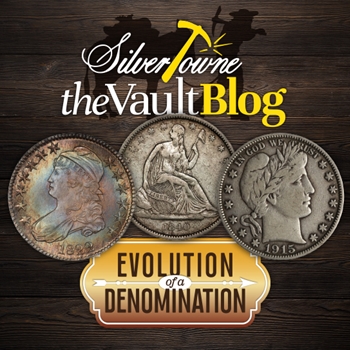
While we all know that design changes occur many times throughout the years when it comes to United States coinage, there are a number of times that it simply occurs because of a change in leadership. That is certainly the case with the half dollar denomination as it phased out the Draped Bust half dollar in favor of a new design in the early 1800s.
Capped Bust, Lettered Edge (1807-1836)
While the Draped Bust (1796-1807) design did not necessarily leave a bad taste in the mouths of the public, it could not survive a change in leadership at the United States Mint. Robert Patterson, the fourth United States Director of the Mint, arrived in 1806 and soon after he called for a design change across the board. When it comes to the half dollar specifically, John Reich took the reins for the new design.
Reich was able to encompass elements of every coin from the half cent to the half eagle in the new Capped Bust half dollar design. Featuring a left-facing Liberty with curly hair tucked into a cap featuring the word “Liberty” on it, the obverse includes a circle of 13 stars with the date below. The reverse features an eagle with a shield upon its breast. Its first year in production was 1807 and the original design lasted until 1808. Another slightly altered version appeared in 1809 and lasted until 1836 (with the exception of 1816).
Capped Bust, Reeded Edge (1836-1839)
Up until 1836, United States coins were made on screw presses. However, a new steam press was introduced in 1836 and over 1,200 half dollars were struck and were among the first U.S. coins that were made for circulation in this new style of production. These half dollars, in addition to over 8.7 million more were struck between 1837 and 1839 featuring the Capped Bust design with the alternate edge.
Switching from the lettered edge to reeded edges in 1836, the design appeared a lot like John Reich’s version but with subtle changes on the reverse and obverse made by new Mint Engraver Christian Gobrecht. Shortly after the adoption of the new edge and a variety of minor detail changes, the Capped Bust half dollar design would ultimately discontinue in 1839, paving the way for Gobrecht’s new Seated Liberty design.
Liberty Seated (1839-1891)
After the introduction of steam powered coinage in 1836, it would not be long until coin designs were made to match aesthetically. The new form of Liberty was featured as a seated figure with her right hand resting on a shield and her left hand holding a Liberty cap—both design elements representing preparedness and freedom. Gobrecht’s design lasted nearly into the 20th century, before it gave way to a new design series. However, the Seated Liberty design lasted with many design changes throughout its years including a No Motto variety, With Arrows & Rays, With Arrows & No Rays, Motto Above Eagle, and Arrows at Date.
Despite its 50+ year run, the series was discontinued in the early 1890s and the Barber (or Liberty Head) design was adopted.
Source: NGC Coin; The Official 2023 Red Book







